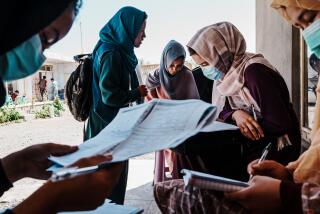Rich Tapestries Lift Hopes in Bangladesh
- Share via
DHAKA, Bangladesh — Bangladesh tapestry--colorful, finely detailed works of art stitched on to simple cotton or silken sheets--has given thousands of poor, downtrodden Bangladeshi women a glimmer of hope.
“We had virtually no future beyond begging or menial labor for meager portions of food,” said Shefali Rani Roy, a tapestry worker from northern Jamalpur district sent to Dhaka for a weeklong tapestry exhibition.
Shefali Rani Roy is one of thousands of women--orphans, widows, abandoned wives, or women ill-treated by their husbands--who have been trained in the ancient art of tapestry in order to support themselves.
The intricate, highly prized works, called Nakshi Kantha --meaning embroidered quilt--have been made for generations by poor Bengali women for the homes of the rich.
The craft was dying out for lack of patronage when Maureen Berlin, wife of a former Canadian ambassador in Bangladesh, arrived in Dhaka in 1980.
Berlin became involved in a project making jute craftworks, but in 1981 she started a new program for Bangladeshi women making tapestry.
Several similar programs were set up in the next few years. Together they now employ about 10,000 women across Bangladesh, officials said.
The tapestries detail various designs--all by Bangladeshi artists--showing village scenes, landscapes, religious festivals and animals.
One of the most popular designs at the recent exhibition at the Aarong workshop, the capital’s biggest tapestry showroom, was The Lonely Peacock, depicting a number of peacocks dancing in the rain, watched by a solitary bird.
The Bangladeshi government has given tapestries to distinguished foreign visitors, including Britain’s Queen Elizabeth II.
Sales centers almost ran out of supplies in June when Marines from a U.S. task force swarmed to buy the tapestries before going home at the end of a disaster relief mission.
The 7,000 servicemen arrived after the devastating April 29 cyclone that killed more than 138,000 Bangladeshis and left millions homeless.
“Nakshi Kanthas are fast becoming one of the top items on the list of our handicraft exports,” said an official with the Bangladesh Rural Advancement Council, a non-governmental organization that supports tapestry work.
Aarong employs hundreds of university students as sales assistants.
“We prefer students for the job because they are smart, have taste and skill to convince buyers, especially the foreigners,” an Aarong executive said.
“It is not only money we work here for,” said sales assistant Sharmin Akhtar. “Instead, we feel a great attachment telling the visitors about us--our rich past, toiling present and bounties of nature.”
Prices of the Nakshi Kanthas, traditionally hung on walls or kept in glass cases in the drawing rooms of the rich, are high in this impoverished country.
One 5-foot by 7-foot piece costs up to $300 on the local market, although outside Bangladesh it would probably fetch at least twice the price.
“Still it isn’t a fair price if you consider that a kantha required 10 women to work for a month to stitch it,” one Aarong official said.
Most of the money earned from the tapestries goes to organizations such as Aarong, which hire the women, train them for three months and give them the designs to work from.
The monthly in come of the tapestry worker herself is seldom more than $30, compared to an average of $45 earned by Bangladeshi workers in fabric industries.
“How can this be enough? I have three children and my old mother to look after,” one woman complained.
But, although the monthly income is meager, it is better than the alternative facing village women, particularly those abandoned by their husbands, who would otherwise have no means of support.
More to Read
Sign up for Essential California
The most important California stories and recommendations in your inbox every morning.
You may occasionally receive promotional content from the Los Angeles Times.













